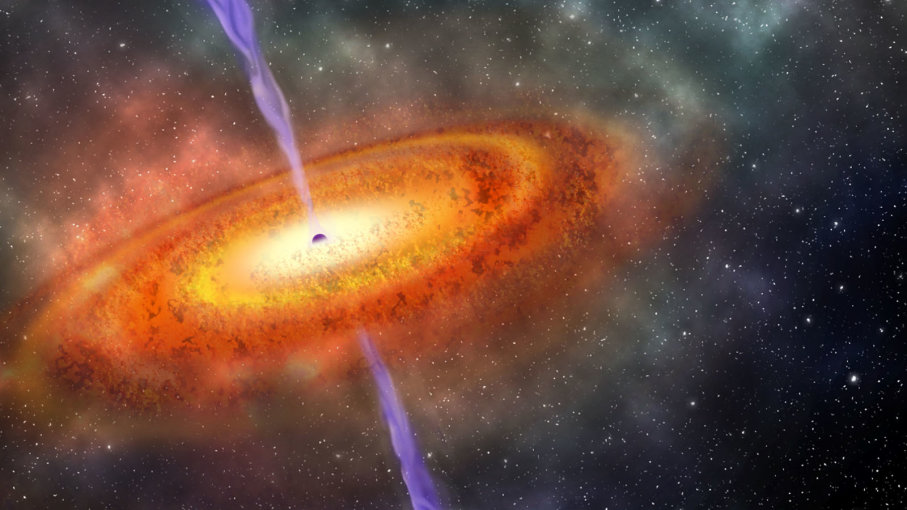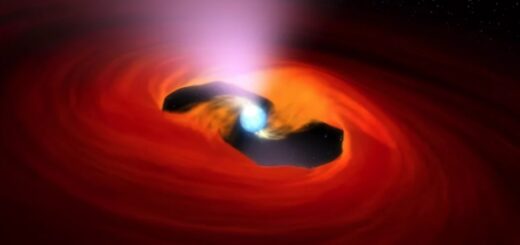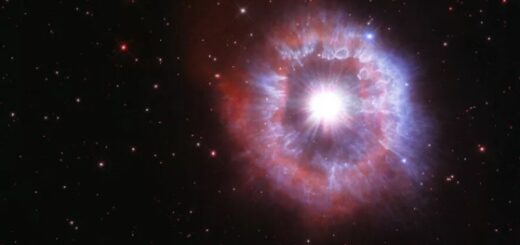Most Distant Black Hole Discovered, But Why Is It Such a Monster?

This artist’s illustration captures the most distant supermassive black hole that humans have discovered. Its rapid growth rate has astronomers scratching their heads. ROBIN DIENEL/CARNEGIE INSTITUTION FOR SCIENCE
Astronomers have discovered the most distant black hole ever observed — and it’s astonishingly big for its young age.
Weighing in at 800 million solar masses, this supermassive specimen was found in the center of a young galaxy that’s generating powerful radiation. Known as a quasar, this type of galaxy lit up the early universe, and their extreme activity was driven by the black hole dynamos in their cores. But this black hole is much bigger than expected for such a young galaxy.
“This black hole grew far larger than we expected in only 690 million years after the Big Bang, which challenges our theories about how black holes form,” said Daniel Stern in a statement from NASA’s Jet Propulsion Laboratory. Stern’s the co-author of a new study published in the journal Nature.
Cosmic Birth and the Dark Ages
Let’s travel further back in time to fully appreciate how ground-breaking this discovery is.
After the Big Bang, the rapidly expanding universe was filled with a hot soup of ionized gas, called a plasma. As time went on and the universe cooled, this plasma condensed into neutral atoms (mainly hydrogen, where one proton combines with an electron). Up until this point, the universe had no stars and no galaxies; there simply had not been enough time for stuff to clump together under gravity to create stars. This period was aptly named the “Dark Ages” because the only radiation that existed at that time was the background afterglow from the Big Bang itself, and it was rapidly becoming redshifted as the universe expanded. Redshift occurs when the expanding universe stretches light from short wavelengths to long wavelengths.
As the first stars sparked into existence and became corralled by their mutual gravity to form the first galaxies, however, the universe underwent monumental change.
These first galaxies generated powerful radiation that broke down the neutral hydrogen gas, stripping the electrons from protons. Known as “reionization,” the universe once again became a plasma state. Normally, this highly ionized gas would be opaque to radiation, but since the universe had expanded and cooled, the plasma was so dispersed that light from the galaxies traveled through intergalactic space mostly unimpeded. It’s as if the cosmos flicked the starlight switch.
Emerging From Cosmic Dawn
So, what does this supermassive black hole have to do with this dramatic cosmic transformation?
Observations of the quasar, called ULAS J1342+0928, have shown it to be surrounded by neutral hydrogen. The neutral hydrogen existing around this baby galaxy means that it’s only just emerged from this reionization period, making it the earliest galaxy that we can see, as it is amongst the first population of galaxies to form.
“The new quasar is itself one of the first galaxies, and yet it already harbors a behemoth black hole as massive as others in the present-day universe!” said co-author Xiaohui Fan, who works at the University of Arizona, in a press release.
Detecting this object was no easy task. The light from J1342+0928 has taken more than 13 billion years to reach us, so it’s extremely faint and very redshifted. Quasars were powerful generators of short-wavelength radiation, like X-rays. But after traveling 13 billion light-years, the radiation has been stretched to the infrared part of the spectrum, so only the most sensitive infrared survey telescopes can detect it.
Using data generated from an international trifecta of powerful telescopes, the researchers were able to seek out quasar candidates in the furthest reaches of the cosmos. Once identified, other observatories pitched in to characterize this extreme object.
The Gemini Observatory in Hawaii, for example, helped determine the black hole’s enormous mass by probing the infrared spectrum to gauge the activity of the black hole. Quasars were such powerful generators of radiation in the early universe because the supermassive black holes in their cores had access to a huge quantity of material. As they rapidly consumed this matter, the black holes formed a vast, hot and radiating accretion disk, creating the quasars’ trademark light that can be seen across billions of light-years.
The next step is to search for more quasars like J1342+0928, and the researchers estimate there must be between 20 and 100 quasars like it across the entire sky.
Quasar 3C 273
Quasar is short for quasi-stellar radio source. The one pictured, 3C 273, is the first one astronomers ever identified, and it’s also the brightest.
ESA/HUBBLE & NASA
Too Big?
Now that we know J1342+0928 is home to an 800 million solar mass supermassive black hole, the big question is, how the heck did it get so gargantuan?
Some of the biggest questions hanging over modern cosmology and astrophysics focus on supermassive black holes. These monsters are known to hide in the cores of most galaxies, including our own, and we know that they can have the mass of a billion suns. Trying to explain how the supermassive black holes in our modern universe consumed enough matter to become so big is difficult enough, but finding an 800 million solar mass monster that existed only 690 million years after the Big Bang is a serious head-scratcher. How did this baby black hole grow so big so fast?
The mechanisms behind black hole accretion are poorly understood, but the researchers suggest that this example may just have been an “early bloomer” that had an extremely active youth, only to settle down as a “regular” supermassive black hole in a large elliptical galaxy.
“If it is located in a denser than average part of the universe, it could get an earlier start in life and grow more quickly,” Fan said in a statement.
“This finding shows that a process obviously existed in the early Universe to make this monster,” added astronomer Eduardo Bañados, at the Carnegie Institution for Science who led the international study. “What that process is? Well, that will keep theorists very busy!”



 Creators of mankind
Creators of mankind Description of “Tall white aliens”
Description of “Tall white aliens” Where they came from?
Where they came from? About hostile civilizations
About hostile civilizations The war for the Earth
The war for the Earth “Tall white aliens” about eternal life
“Tall white aliens” about eternal life Video: “Nordic aliens”
Video: “Nordic aliens” Aliens
Aliens Alien encounters
Alien encounters The aliens base
The aliens base UFO
UFO Technology UFO
Technology UFO Underground civilization
Underground civilization Ancient alien artifacts
Ancient alien artifacts Military and UFO
Military and UFO Mysteries and hypotheses
Mysteries and hypotheses Scientific facts
Scientific facts


















